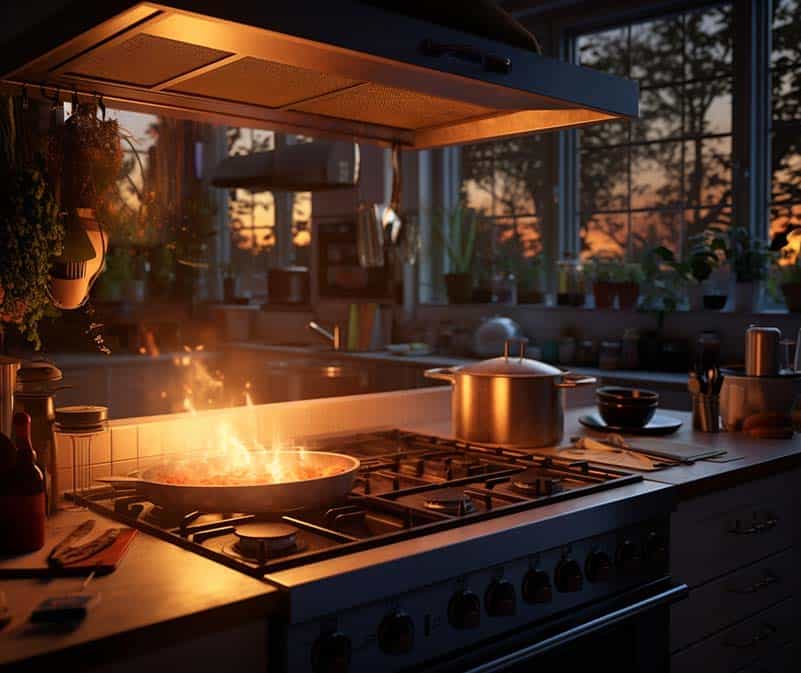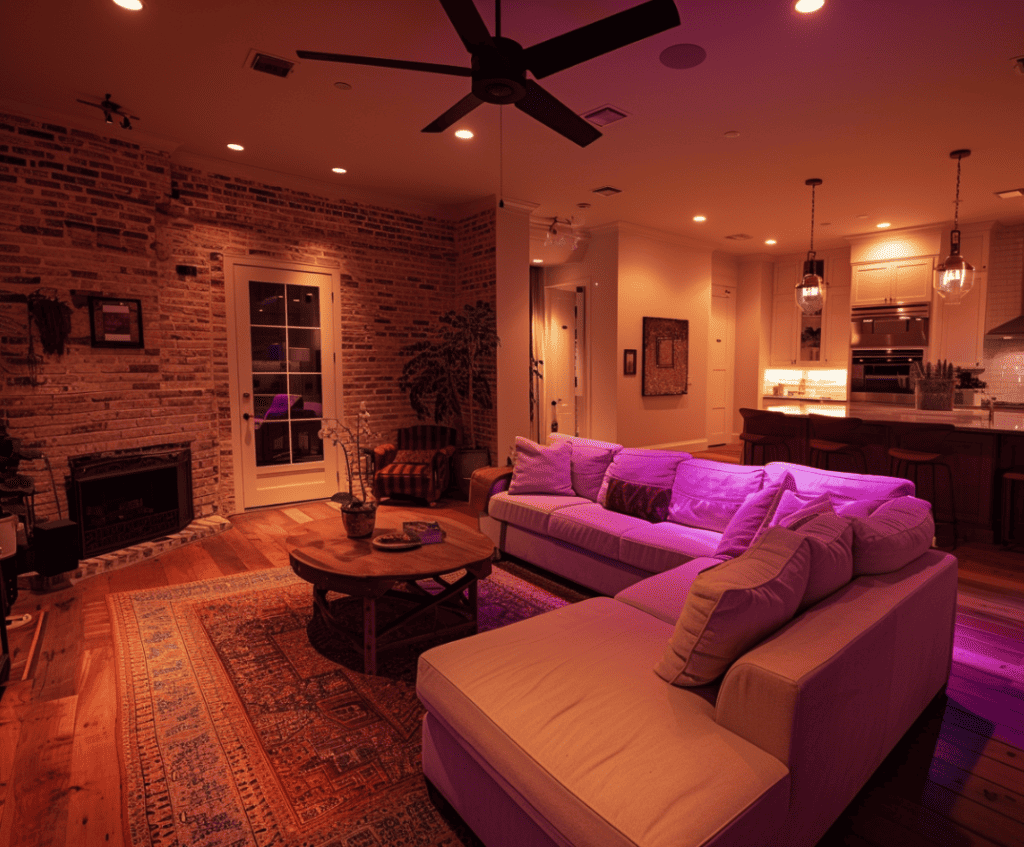Electrical Safety Inspections: Avoiding Home Electrical Fires

As electricians in San Antonio, TX performing home electrical safety inspections year in year out, we are particularly alert to the root causes of electrical fires. We have observed too many code violations not to know that unbeknownst to their owners, homes in our region are often at a high risk of burning.
Each year between 2012 and 2016, Fire Departments across the U.S. received over 44,000 emergency calls to put out home electrical fires. These incidents would not have been as frequent if homeowners had kept their electrical installations up to code and adopted basic home electrical safety measures.
Even worse, this trend has accelerated, with over 158,000 home fires reported each year between 2017 and 2021.
Home electrical fires are devastating, from loss of irreplaceable personal heirlooms, to loss of human and animal life. In apartment buildings, fires can easily propagate from one floor to another, and ruin the lives of many families.
Home Electrical Fires: The Research
A comprehensive report titled “Home Electrical Fires” prepared by Richard Campbell and published in March 2019 by the National Fire Protection Association (NFPA) provides a comprehensive analysis of home fires involving electrical failure or malfunction. [Note: the publisher removed the original study from their website for the time being, but a new version prepared by Marty Ahrens can be downloaded here.]

This report shows that home fires resulted in an estimated average of 440 civilian deaths and 1,250 civilian injuries. They also caused $1.3 billion in direct property damage annually.
The report is based on data from 2012 to 2016. It aims to inform public policy, code changes, and public education initiatives. This is a critical resource for understanding the scope and characteristics of home electrical fires. It has contributed to the development of effective prevention strategies.
We also used a more recent report titled “Home Cooking Fires” prepared by Shelby Hall and Tucker McGree. It was published in September 2023 by the NFPA, and has been republished in an abbreviated form here. It shows that cooking accounted for an average 158,000 home fires reported each year between 2017 and 2021.
These numbers and the acceleration of these events is extremely concerning. All the following areas are on our list of topics of interest when we conduct a home electrical safety inspection.
In this article, we recommend actions you can do to prevent home electrical fires.
I. Distribution of home electrical fires by type of cause and device
The NFPA research reports establishe 5 categories of causes and devices likely to catch on fire or provoke a fire. Their 2012 report quantifies the incidents in this manner:
- Electrical distribution, lighting, and power transfer equipment: These accounted for half (50%) of home fires involving electrical failure or malfunction.
- Cooking equipment: Responsible for 15% of home fires involving electrical failure or malfunction. [Note: The figures reported for the period 2017-2021 dwarf this percentage.]
- Heating equipment: Accounted for 9% of such home fires.
- Fans: Contributed to 6% of home fires involving electrical failure or malfunction.
- Air conditioners and clothes dryers: Each accounted for 3% of such home fires.
Let’s do a deep dive in the first cause for these home fires: Electrical Distribution, Lighting, and Power Transfer Equipment.
II. Electrical Distribution, Lighting, and Power Transfer Equipment
A. Types of Electrical Distribution and Lighting Equipment Involved

- Faulty wiring in concealed spaces, such as attics or behind walls, is particularly dangerous. It can start fires that burn for a prolonged period before detection.
- Wiring and related equipment accounted for two-thirds of home fires caused by electrical distribution and lighting equipment. These also caused over half of the civilian deaths and injuries.
B. Factors Contributing to Ignition
- Electrical failure or malfunction is a factor in nearly 79% of home fires involving this category. This primarily involves some form of arcing, an unintentional discharge of electrical current between conductors.
- Equipment or circuit overload accounted for 3% of such fires.
C. Area of Origin
- Almost one in five home fires (17%) involving electrical distribution or lighting equipment originated in a bedroom, followed by attics or ceilings (12%) and wall assemblies or concealed spaces (9%).
D. Trends and Timing
- There has been a steady downward trend in home fires due to this cause since 1980, although there were some fluctuations.
- Approximately one-quarter (24%) of these fires occurred between midnight and 8 a.m., but these fires accounted for 60% of deaths.
E. Recommendations
- Research shows that aluminum wire connections are prone to deterioration, leading to hazardous overheating. The Consumer Product Safety Commission (CPSC) recommends that qualified electricians replace or repair home aluminum wiring.
The report suggests that the complexity and concealed nature of electrical distribution systems make them particularly hazardous. Faulty wiring and electrical malfunctions are significant contributors, often going undetected until it is too late. It also emphasizes the need for regular home electrical safety inspections and upgrading electrical systems. This is particularly the case of older homes.
F. Thoughts from a Licensed Electrician
An electrician needs to have thousands of hours of study and years of practical experience to achieve State certification. In Texas, an apprentice must complete 8,000 hours of on-the-job training and pass a complex State examination in order to get his professional license and be able to operate on his own.
Whenever we see homeowners wiring their home themselves, we know they probably jeopardize their family’s safety. Two factors explain the critical code violations we observe when conducting electrical safety inspections: (a) homeowners did the job and didn’t know what they were doing, and (b) old wiring became obsolete, either because the material used was out-of-date, degraded and unsafe, or because the electrical load of the home increased with new appliances added.
It is unwise to try to save a penny by DIY’ing an electrical installation. You risk losing your home and endangering the lives of your loved ones. If you live in an older home, chances are your wiring is not up to code. It is also possibly degraded because of heat and temperature variations. When the sheathing around the wire dries out and cracks, the risk of electrical fire is real. Have a licensed electrician like All Star Electric come to your home and perform an electrical safety inspection.
III. Cooking equipment

The second NFPA report we mentioned earlier is titled “Home Cooking Fires” and has just been republished (September 2023). It provides a comprehensive analysis of the causes, circumstances, and consequences of home cooking fires in the United States.
Perhaps the most alarming figure of this report is that cooking is the second leading cause of home fire deaths.
Between 2017 and 2021, cooking caused an average of 158,400 reported home fires per year. This resulted in 470 deaths and 4,150 injuries annually.
A. Key Factors Contributing to Cooking Fires
- Unattended cooking: This is the leading factor contributing to cooking fires. It is often the case that cooks leave the room or even the house while cooking, leading to fires.
- Combustible materials: Wrappers, potholders, or clothing can catch fire when too close to hot cooking equipment.
- Cooking methods: Certain types of cooking, such as frying, broiling, and boiling, require continuous attention. Lack of attention during these cooking methods often leads to fires.
- Cooking oil and grease: More than two-thirds of home cooking fires began with the ignition of cooking materials. This includes food, fat, and grease. Cooking oil or grease fires were particularly dangerous. They contributed to more than half of the deaths and three-quarters of the injuries.
B. Demographics and Timing
- More than half of the people who died in cooking fires were 55 years of age or older.
- Cooking fires peaked between 5:00–8:00 p.m., likely when people are preparing dinner.
C. Equipment Involved
- Ranges or cooktops were involved in 53% of the reported home cooking fires. They caused 88% of the deaths, and 74% of the injuries.
D. Recommendations
- The report emphasizes the importance of staying in the home and checking on the cooking regularly.
- For small oil or grease fires, smother the flames by sliding a lid over the pan. Turn off the burner.
E. Smoke Alarms
- A working smoke alarm is necessary to alert those outside the kitchen of a fire. Smoke alarms were present at 88% of the reported home cooking fires and 76% of the cooking fire deaths.
According to the report, smoke alarms were more likely to be present at fires caused by cooking than at all other home fires. But victims in fires from clothing ignitions may have been fatally injured before the smoke alarm sounded.
F. Thoughts from a Licensed Electrician
This recent report suggests that people ought to be much more aware of the risks associated with cooking. They should especially be familiar with what to do to avoid oil and grease fires.
It also highlights the importance of smoke alarms in preventing fatalities and injuries.
In view of the gravity of these risks, we recommend:
- Ask a licensed electrician to inspect your smoke alarm systems during an electrical safety inspection
- Have a small fire extinguisher handy, on a wall or on a shelf, near your cooking station.
Retailers now sell fire extinguishers in the form of spray bottles simply activated by a push-button. These are much simpler to use than traditional extinguishers: no pin to pull. You can also handle them with just one hand.
Lastly, we would recommend parents to teach their children the gestures likely to protect them from burns. Snuff out a cooking fire by sliding a lid over a pan, and turn off the burner. Simple gestures parents and children to should drill to do them automatically in a moment of panic.
IV. Heating Equipment

The NFPA republished another report titled “Home Heating Fires“, originally prepared by Richard Campbell and published in December 2022. It provides a comprehensive analysis of the role of heating equipment in home fires in the United States. Based on data from 2016 to 2020, it sheds light on the causes, trends, and safety measures related to home heating fires.
Key Findings
- Heating equipment is a leading cause of fires in U.S. homes. It is responsible for an estimated annual average of 44,210 home structure fires.
- These fires resulted in approximately 480 deaths, 1,370 injuries, and over $1bn in direct property damage each year.
- Space heaters were most often the culprits, accounting for one-third of the fires and most of the deaths and injuries.
- Fires caused by heating equipment were less likely to occur between 12 a.m. and 6 a.m. However, they accounted for 43% of fatalities.
B. Types of Heating Equipment Involved
Space heaters were responsible for the largest share of losses. They accounted for one-third of the fires but nearly 90% of the deaths and 80% of the injuries. Other types of heating equipment involved were central heat systems, water heaters, and fuel burners or boilers.
C. Trends Over Time
The report indicates a downward trend in the number of home fires involving heating equipment since 2000. Improvements in safety standards, such as automatic cut-off devices for space heaters, have likely contributed to this decline.
D. Dwelling Types
Single-family homes with year-round occupancy accounted for the largest share of home heating fires (45%). They also account for 88% of deaths and 74% of direct property damage. Multifamily residences accounted for a smaller share of fires but nearly one-fifth of the civilian injuries.
E. Time and Seasonal Patterns
Fires were more likely to occur during the cold weather months, with nearly half occurring from December through February. The peak period for fires was from 6 p.m. to 9 p.m.. But fires occurring between midnight and 6 a.m. accounted for a disproportionate share of deaths and injuries.
F. Area of Origin and Safety Measures
Fires originating in the kitchen accounted for the largest share of home heating fires (17%). They also caused the largest shares of injuries (44%) and direct property damage (19%). The report also provides safety tips. Keep flammable materials at least three feet away from heating equipment. Have heating equipment inspected annually.
G. Thoughts from a Licensed Electrician
This report is a reminder that people need to be careful when using space heaters. The improvement in safety standards prevents them from continuing to operate when they tip over. But protective circuitry does not prevent all bad situations from happening.
How your place your space heaters in your rooms is also extremely important. The intense heat emanating from these devices can easily set flammable materials on fire. We recommend looking at curtains, synthetic fabrics, light shawls, polyester rugs, etc.
The data show that a great number of these home electrical fires occurs at night, when people sleep. People regularly leave rooms with a space heater on. If there is any flammable material near it, the risk of fire immediately increases. No one notices a fire just started… Then it’s too late.
This is something a licensed electrician like All Star Electric will not miss during a home electrical safety inspection.
V. Fans

We found an older document titled “Home Fires Involving Air Conditioning, Fans or Related Equipment Fact Sheet” published by the NFPA.
It contains a detailed analysis of the role of fans in home fires (Period: 2006 to 2012).
It sheds light on the causes, trends, and safety measures related to home fires involving fans.
[Note: Unfortunately, the NFPA removed access to this document on its website. However, they published a useful downloadable tip sheet called “Top 10 Winter Freeze Tips” here.]
But let’s discuss the finding of the original study.
A. Key Findings
- During the period, fans were involved in 3,880 home fires per year on average, with 13 deaths and 130 injuries. They caused $77 million in direct property damage on average per year.
- Portable fans were involved in one-quarter (23%) of the fan fires, 82% of the deaths, 47% of the injuries.
- Half (52%) of the stationary fan fires started in the bathroom. Nearly half (45%) of the portable fan fires started in the bedroom.
B. Types of Fans Involved
This report distinguishes between portable fans and stationary/installed fans.
Portable fans were particularly dangerous, accounting for a disproportionate number of deaths and injuries. This suggests that the portability and common usage of these fans around the home may contribute to their higher risk.
C. Area of Origin
This report provides data on the areas where fan fires most commonly originate. For stationary fans, the bathroom was the most common area of origin, accounting for 52% of such fires. For portable fans, the bedroom was the most common area, accounting for 45% of fires.
D. Seasonal and Monthly Trends
The report indicates that 33% of fan fires occurred during the summer months of June, July, and August, due most likely to increased usage of fans during the hotter months, which could lead to overheating and electrical issues.
E. Electrical and Mechanical Factors
The report notes that electrical and mechanical factors were the leading causes of home air conditioning, fan, or related equipment fires. While it doesn’t delve into specifics, this suggests that issues like electrical overloads, mechanical failures, or lack of maintenance could be significant contributing factors.
F. Safety Recommendations
While the report does not provide explicit safety recommendations for fan usage, the data implies that proper maintenance and cautious placement of fans—especially portable ones—could mitigate risks. Given that electrical and mechanical issues are leading causes, regular inspection and servicing of fans could be beneficial.
G. Thoughts from a Licensed Electrician
This report underscores the necessity to keep an eye on your fans, notably during the hot season.
Perhaps the most surprising data in this NFPA fact sheet is the percentage of fires started by installed fans vs. mobile fans. The fact that most fires involve fans installed in a bathroom could be due to the humidity in this area of our homes.
From our experience as electricians conducting home electrical safety inspections, we have also observed that bathroom ceiling installed fans are often heavily loaded with lint and dust. This is a reminder that it is necessary to clean your fans periodically.
An electrical fire starting from a stationary fan can also betray that it was badly connected to the mains by a non-electrician.
So while the location of fans (especially mobile fans) definitely matters, the possibility that an electric fire could start because a fan has not been properly wired is a strong signal that electricity is dangerous when handled incorrectly.
Call a professional, licensed electrician like All Star Electric to securely connect your ceiling fans and perform a home electrical safety inspection every so often.
VI. Clothes Dryers and Washers

Richard Campbell prepared another report titled “Home Fires Involving Clothes Dryers and Washing Machines” which was published by the National Fire Protection Association (NFPA) in March 2017. This report provides a complete analysis of home electrical fires caused by clothes dryers and washing machines between 2010 and 2014.
[Note: The report is not available anymore on the NFPA website, but they published a practical “Clothes Dryer Safety Tip Sheet” here.]
A. Key Statistics
- An estimated 15,970 home fires involving clothes dryers or washing machines occurred each year.
- These fires resulted in 13 civilian deaths, 440 civilian injuries, and $238 million in direct property damage annually.
- Clothes dryers were involved in 92% of these fires.
B. Leading Causes and Contributing Factors
- The leading cause of home clothes dryer and washer fires was failure to clean the lint filter, accounting for 31% of the incidents.
- Mechanical failure or malfunction contributed to 28% of dryer fires and 44% of washing machine fires.
- Electrical failure or malfunction was a factor in 17% of dryer fires and 42% of washing machine fires.
C. Items First Ignited
- In clothes dryer fires, the leading items first ignited were dust, fiber, or lint (27%) and clothing (26%).
- In washing machine fires, the leading items first ignited were electrical wire or cable insulation (26%) and appliance housing or casing (24%).
D. Area of Origin and Power Source
- The majority of these fires originated in laundry rooms or areas.
- Equipment powered by electrical line voltage accounted for almost two-thirds of the fires.
E. Safety Information and Standards
The report also includes safety guidelines for preventing dryer fires.
Actions you can do yourself:
- Clean the lint filter: Before or after each use, the lint filter should be cleaned to prevent accumulated dust and lint, which can be a fire hazard.
- Proper airflow: Ensure that the dryer sustains proper air flow and drying time. Replace plastic ducting from the dryer as it can trap lint and is susceptible to kinks or crushing, reducing airflow.
- Electrical needs: Make sure the dryer is plugged into an outlet suitable for its electrical needs.
- Clear area: Keep the area around the dryer clear of combustibles like boxes and clothing.
- Professional installation: Have your dryer installed and serviced by a professional to ensure it is set up correctly and safely.
- Care with volatile chemicals: Extra care should be taken when drying clothes soiled with volatile chemicals like gasoline, cooking oils, and cleaning agents. If possible, wash the clothing more than once or hang the clothes to dry. Use the lowest heat setting and a drying cycle that has a cool-down period at the end.
- Avoid overloading: Do not overload a washing machine or dryer, and follow the manufacturer’s equipment care and operating instructions. This should reduce the risk of fire due to leaks or broken parts.
- In case of fire: If a fire occurs inside the dryer, do not open the door as it provides more oxygen and could make the fire worse.
Actions a licensed professional must do:
- Regular maintenance: Keep dryers in good working order to avoid problems associated with lack of maintenance and part failures. Gas dryers should be inspected occasionally to ensure that the gas line and connection are intact and free of leaks.
- Proper grounding: Washing machines and dryers should be properly grounded to reduce the risk of electrical problems.
- Professional check: If there are any doubts that the equipment is running properly or safely, have a professional check it.
F. Thoughts from a Licensed Electrician
It is clear from the report that the risk of a home electrical fire starting from a clothes dryer can be attributed to 2 main causes: (a) lack of maintenance, and (b) wrong electrical installation.
When conducting a home electrical safety inspection, professional electricians often ask the homeowners if they sometimes clean the flexible duct that evacuates the hot air from the dryer to the outside. In most cases, the answer is “no” or “very rarely”.
Granted, these ducts are not easy to reach, and we rarely think of them. But they accumulate the lint that isn’t filtered by the mesh filter in the dryer, and the flow of hot air can be enough to start a fire. The wall plate which hides them is another place where lint accumulates; over time, it actually obstructs the airflow, and presents a new fire hazard. Bottom line: vaccum clean your flexible duct, and the wall plate.
The other cause for electrical fire in the laundry room is a wrong installation. Is the wall plug of the right type? Is it properly grounded? Does the service panel feature a breaker of a sufficient size to handle the electrical load of a washer and a dryer?
These are not irrelevant questions, as statistics show: 17% of dryer fires and 42% of washer fires were due to electrical failure. Sometimes, the problem just arises out of a change in appliances: the new appliances installed may be too powerful for the circuit and the breaker. In any case, it is prudent to call a licensed electrician like All Star Electric to perform a home electrical safety inspection, and check out the safety of your laundry room.
Electrical Safety Inspections: Additional resources
All Star Electric’s Home Electrical Safety Inspections
FAQ
Based on NFPA’s research, the potential sources of home electrical fires can be categorized as follows:
1- Electrical Distribution, Lighting, and Power Transfer Equipment
2- Cooking Equipment
3- Heating Equipment
4- Fans
5- Air Conditioners and Clothes Dryers
Keep the cooking area clean to prevent grease buildup, avoid overloading electrical circuits, keep flammable items like towels and paper products away from the cooking area, and ensure functional smoke alarms are installed near the kitchen. Additionally, never leave cooking food unattended.
To decrease the risk of electrical fires in the laundry room, the NFPA recommends several key precautions. Regularly clean the lint filter in your dryer and ensure proper ventilation to prevent overheating. Have electrical circuits for the washer and dryer professionally installed by a licensed electrician to meet safety standards. Store flammable items like cleaning supplies away from electrical appliances. If clothes or rags have been in contact with flammable chemicals, wash them multiple times before drying. Install a functional smoke alarm near the laundry area and get it tested regularly. Additionally, the NFPA advises not to leave home while the dryer is running to ensure quick action in case of a malfunction or fire.
Between 2012 and 2016, fire departments across the U.S. received over 44,000 emergency calls for home electrical fires that could have been avoided if electrical installations had been up to code. This number surged to over 158,000 home fires reported each year between 2017 and 2021. Faulty wiring in hidden spaces like attics or behind walls is particularly dangerous, accounting for 2/3 of home fires caused by electrical distribution and lighting equipment. Electrical failure or malfunction is a factor in nearly 79% of these fires.




























